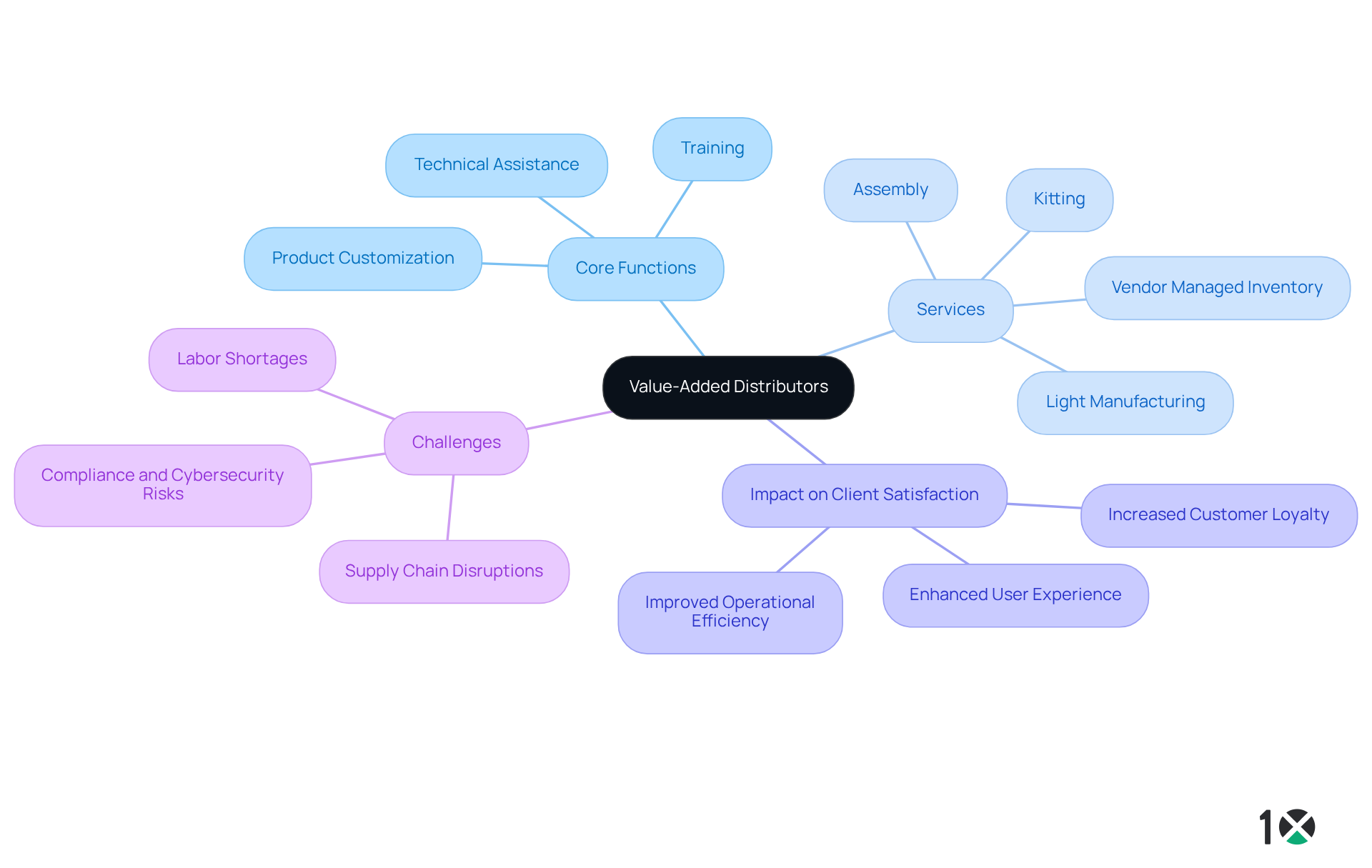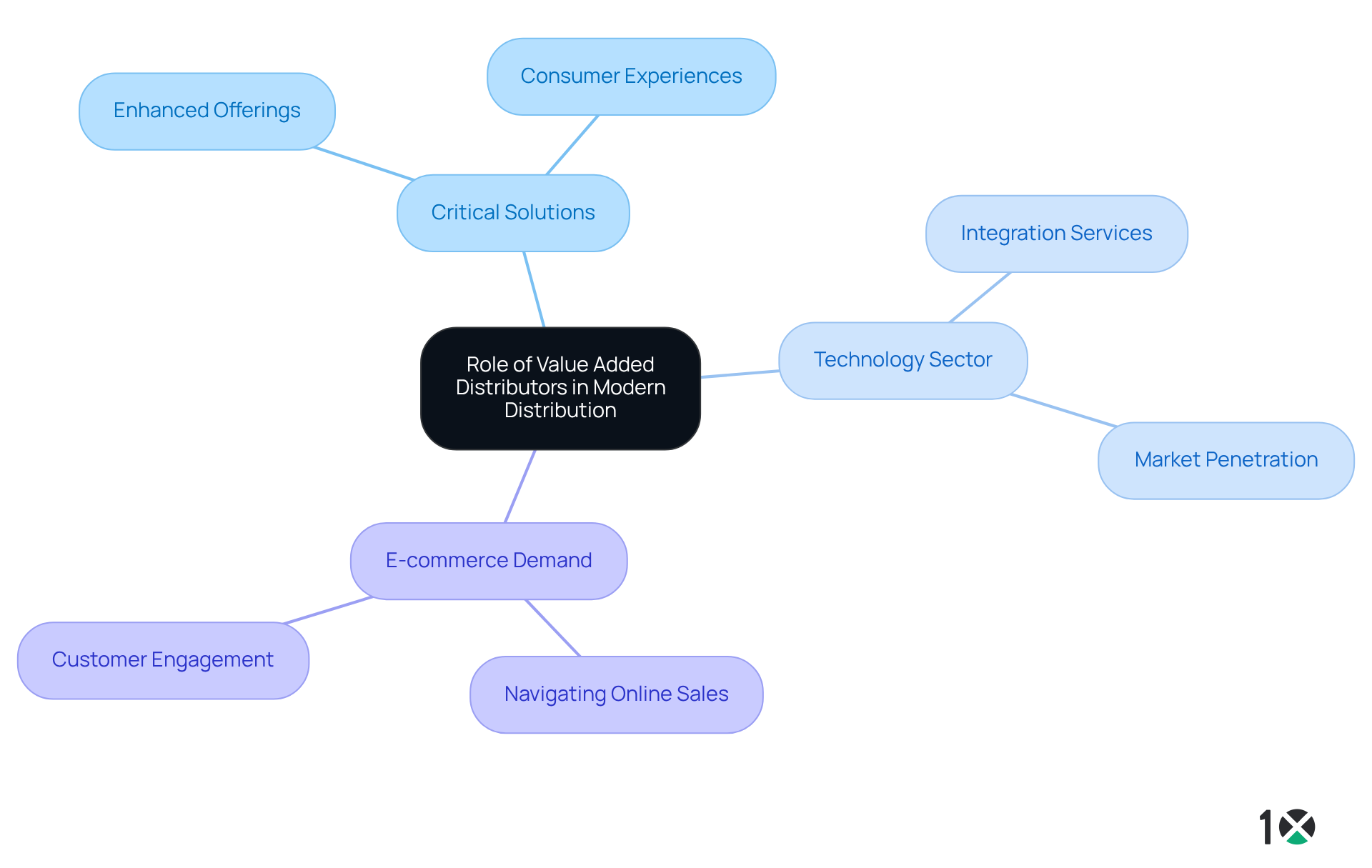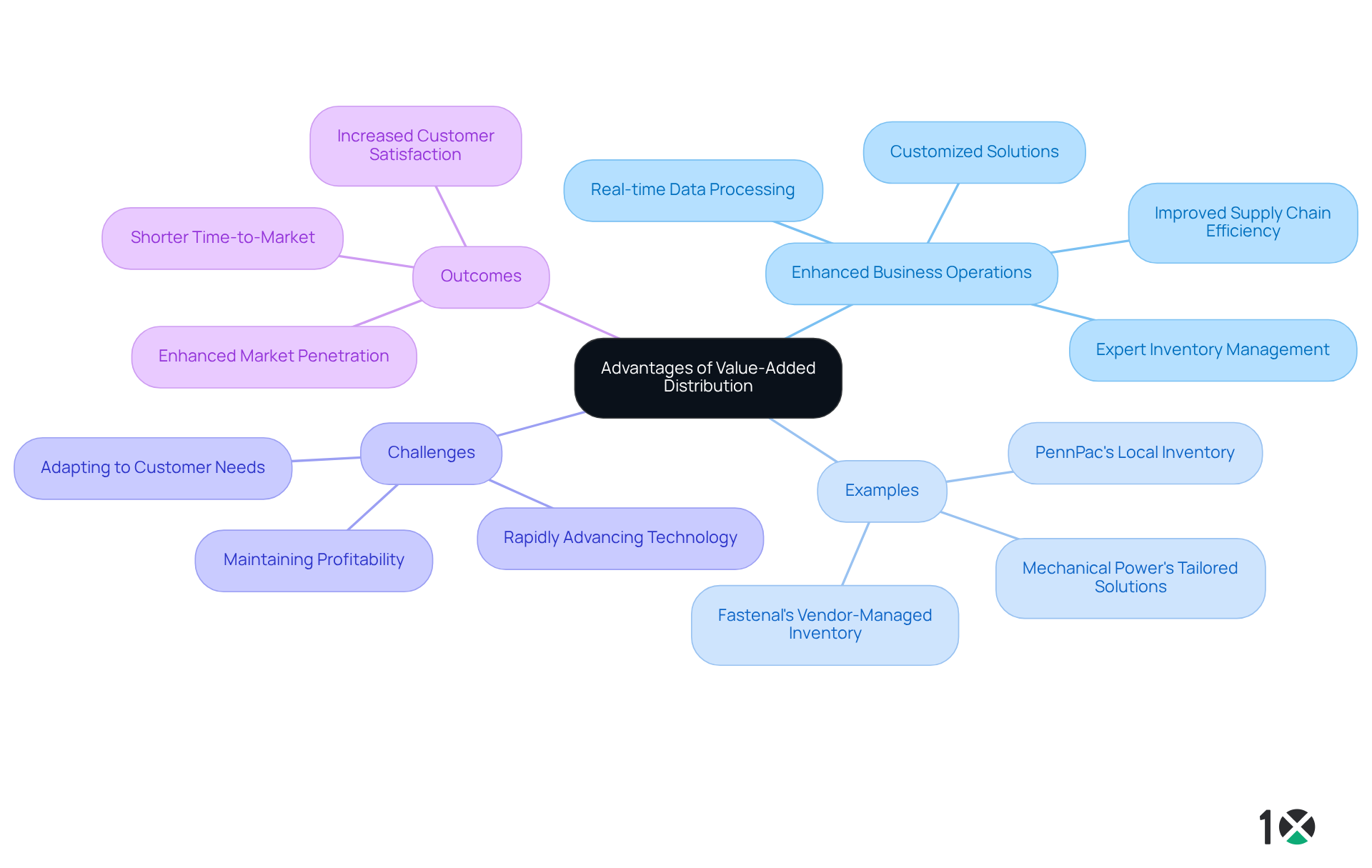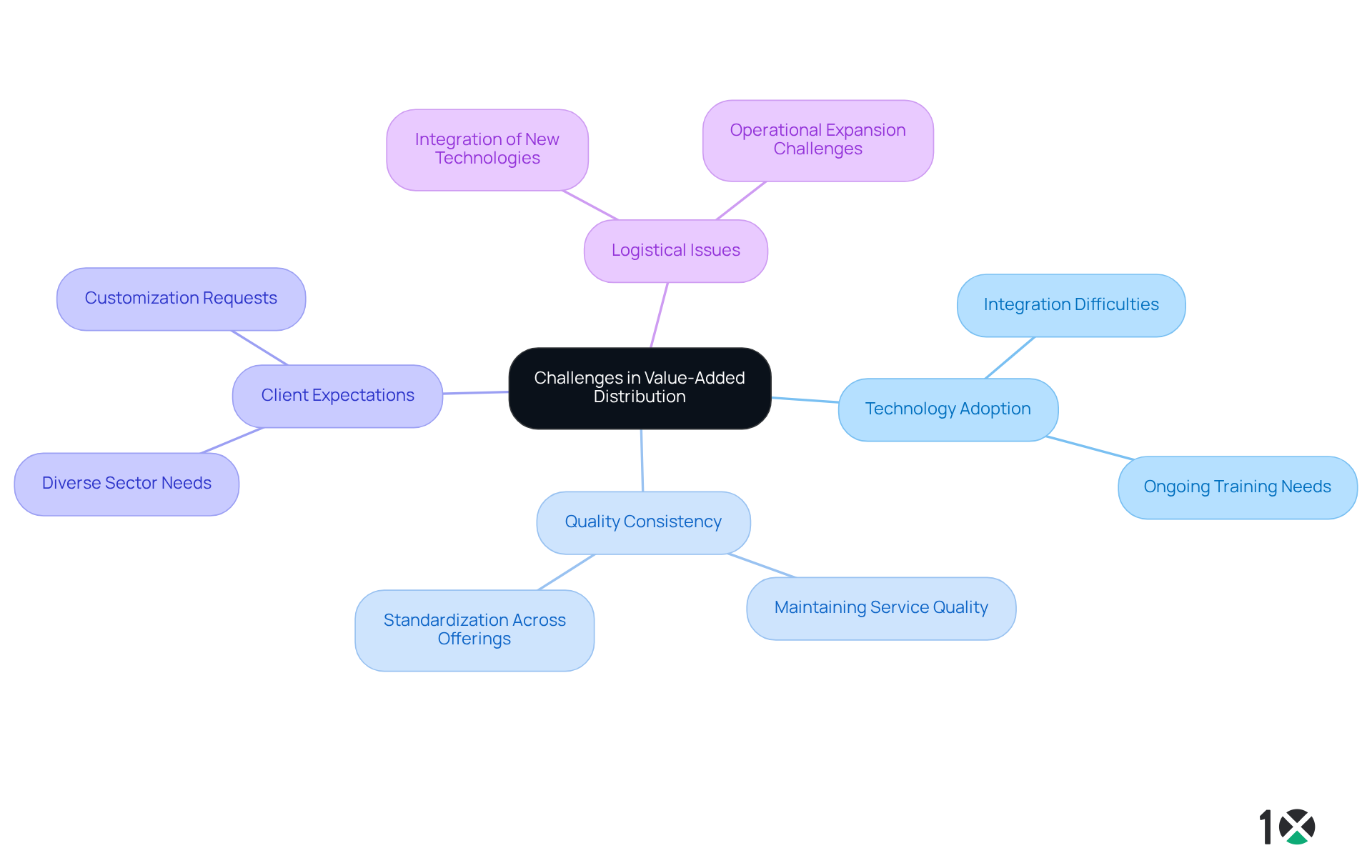Overview
Value-added distributors (VADs) are essential in enhancing product value through services like:
- Technical assistance
- Product customization
- Training
This enhancement leads to significant improvements in customer satisfaction and loyalty. VADs adeptly navigate the complexities of the supply chain, leveraging advanced solutions such as 10X ERP. These tools streamline operations and effectively address the evolving demands of consumers. Consequently, VADs emerge as indispensable partners in the modern distribution landscape.
Introduction
In an increasingly competitive market, businesses are continuously striving to enhance their offerings and elevate customer satisfaction. Value-added distributors (VADs) emerge as essential partners in this pursuit, delivering not only logistics but also a comprehensive suite of additional services that significantly enhance product value and user experience. However, as these distributors navigate the complexities of modern supply chains, they encounter substantial challenges that can impede their effectiveness.
What strategies can value-added distributors implement to surmount these obstacles and maximize their contributions to the distribution process?
Define Value-Added Distributors: Core Concepts and Functions
Value added distributors serve as vital intermediaries within the supply chain, significantly enhancing product value beyond mere logistics and order fulfillment. Value-added distributors, unlike traditional distributors, offer additional support including , all focused on enhancing product performance and ensuring comprehensive user support throughout the product lifecycle. Services like vendor managed inventory (VMI) and kitting not only streamline operations but also boost inventory management efficiency. Furthermore, features such as customizable attributes and lot/serial item tracking provided by 10X ERP empower VADs with precise control over their inventory, thereby further enhancing operational efficiency.
Industry leaders emphasize the critical nature of these offerings, highlighting their substantial impact on client satisfaction and loyalty. As one expert noted, ‘In a competitive environment, value-enhancing offerings can distinguish distributors by addressing client needs and fostering loyalty.’ This perspective underscores the increasing recognition of value added distributors as essential partners across various sectors, particularly within technology and industrial markets. By incorporating these value-added services, distributors not only facilitate the distribution process but also play a pivotal role in enhancing overall customer experiences, rendering them indispensable in today’s dynamic supply chain landscape.
Moreover, it is essential to acknowledge the challenges faced by distributors, such as supply chain disruptions and labor shortages, which further accentuate the importance of value added distributors in navigating these complexities. Effective data management in inventory and order management is crucial for operations managers when evaluating value added distributors. With 10X ERP’s advanced inventory management solutions—including customizable tracking and seamless software integration—these distributors can significantly enhance their operational efficiency.

Contextualize the Role of VADs in Modern Distribution
In today’s dynamic distribution landscape, it is essential to recognize the role of value added distributors. Companies strive to distinguish themselves in competitive markets, and these distributors provide critical solutions that enhance offerings and elevate consumer experiences.
For example, in the technology sector, value added distributors frequently offer integration services, ensuring that products operate seamlessly with existing systems. This adaptability not only allows manufacturers to penetrate specialized markets but also empowers resellers to deliver to end-users.
As e-commerce surges and digital transformation accelerates, the demand for value added distributors intensifies. They expertly navigate the complexities of online sales and customer engagement, making their expertise vital for businesses aiming to optimize operations and meet evolving consumer expectations.

Explore the Advantages of Value-Added Distribution
Collaborating with value added distributors provides significant advantages that can greatly enhance business operations, especially when combined with advanced solutions like 10X ERP. These distributors enrich product offerings by integrating complementary services, such as installation and training, with core products. For instance, PennPac provides customized solutions and manages inventory adeptly, which not only fosters user adoption of new technologies but also boosts sales and market penetration. With the cloud-based platform of 10X ERP, distributors can harness and optimized inventory management, further refining their operations.
Additionally, these distributors improve supply chain efficiency through expert inventory and logistics management, allowing manufacturers to concentrate on their core competencies. Their specialized knowledge, combined with the seamless integrations of 10X ERP, empowers businesses to navigate the complexities of market dynamics and evolving customer demands, leading to increased customer satisfaction and loyalty. However, these distributors face challenges, such as keeping pace with rapidly advancing technology and sustaining profitability in a competitive landscape.
Companies that effectively leverage value added distributors, along with innovative solutions like 10X ERP, often report improved operational performance and a shorter time-to-market for new products. This underscores the strategic value of these partnerships in today’s competitive environment. As Rob Tiller, Managing Director at PennPac, articulates, ‘Value added distributors like PennPac don’t just deliver film—we deliver insight, problem-solving, and flexibility.

Identify Challenges in Value-Added Distribution
Value-added distributors face significant challenges in today’s fast-paced market. The rapidly evolving technology landscape demands that these distributors continuously enhance their knowledge and skills to maintain a competitive edge. Statistics reveal that a substantial percentage of virtual assistants struggle with technology adoption, often citing integration difficulties and the need for ongoing training as primary obstacles. Furthermore, ensuring consistent quality across various offerings becomes increasingly intricate, especially as operations expand.
VAD systems must also navigate the diverse expectations of clients across different sectors, complicating the delivery of assistance. The logistical challenges of integrating new technologies into existing systems further exacerbate these issues. To effectively navigate these hurdles, organizations should prioritize , adopt flexible operational strategies, and cultivate robust relationships with both manufacturers and end-users.
Industry experts emphasize that maintaining quality in the services provided by value added distributors is crucial for long-term success. This highlights the imperative for value added distributors (VADs) to adapt proactively to these challenges, ensuring their competitiveness in a dynamic environment.

Conclusion
Value-added distributors are pivotal in the contemporary supply chain, not only facilitating product distribution but also amplifying value through a range of supplementary services. This multifaceted approach empowers businesses to harness the expertise of these distributors, ensuring they can adapt to the evolving demands of their customers while navigating a complex market landscape.
Key insights throughout the article illustrate how value-added distributors significantly enhance customer satisfaction and operational efficiency. By providing services such as technical assistance, product customization, and inventory management, these distributors enable businesses to streamline processes and cultivate client loyalty. Furthermore, the challenges faced by value-added distributors—including technological advancements and quality assurance—underscore the necessity for ongoing investment in skills and robust industry relationships.
Recognizing the strategic importance of value-added distributors is essential for businesses seeking to excel in competitive environments. Embracing these partnerships not only bolsters operational performance but also equips companies to respond more effectively to market dynamics and customer needs. As the demand for value-added distribution continues to rise, companies are urged to explore these collaborations to unlock new opportunities and drive sustainable growth in their operations.
Frequently Asked Questions
What are value-added distributors (VADs)?
Value-added distributors are intermediaries in the supply chain that enhance product value beyond logistics and order fulfillment by offering additional support such as technical assistance, product customization, and training.
How do value-added distributors differ from traditional distributors?
Unlike traditional distributors, value-added distributors provide extra services that focus on improving product performance and ensuring comprehensive user support throughout the product lifecycle.
What services do value-added distributors offer?
Value-added distributors offer services like vendor managed inventory (VMI), kitting, technical assistance, product customization, and training, which streamline operations and improve inventory management efficiency.
How does 10X ERP support value-added distributors?
10X ERP provides features such as customizable attributes and lot/serial item tracking, which empower value-added distributors with precise control over their inventory and enhance operational efficiency.
Why are value-added distributors considered essential partners in various sectors?
They are recognized as essential partners because they address client needs, enhance customer experiences, and foster loyalty, particularly in competitive environments like technology and industrial markets.
What challenges do value-added distributors face?
Value-added distributors face challenges such as supply chain disruptions and labor shortages, which highlight their importance in navigating these complexities.
What role does effective data management play for value-added distributors?
Effective data management in inventory and order management is crucial for operations managers to evaluate and enhance the efficiency of value-added distributors.
What advanced solutions does 10X ERP offer to enhance operational efficiency?
10X ERP offers advanced inventory management solutions, including customizable tracking and seamless software integration, which help value-added distributors improve their operational efficiency.
